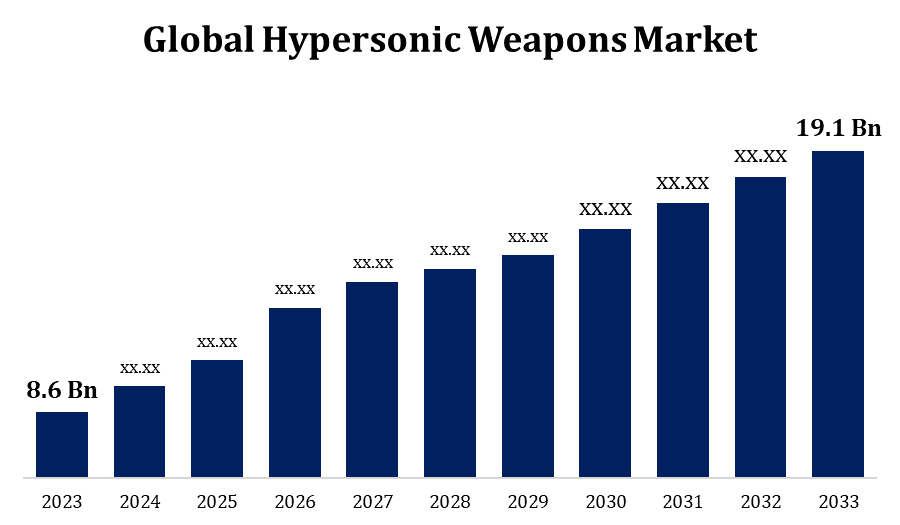Global Hypersonic Weapons Market Size To Worth USD 19.1 Billion By 2033 | CAGR of 8.31%
Category: Aerospace & DefenseGlobal Hypersonic Weapons Market Size To Worth USD 19.1 Billion By 2033
According to a research report published by Spherical Insights & Consulting, the Global Hypersonic Weapons Market Size to Grow from USD 8.6 Billion in 2023 to USD 19.1 Billion by 2033, at a Compound Annual Growth Rate (CAGR) of 8.31% during the forecast period.

Get more details on this report -
Browse key industry insights spread across 200 pages with 120 Market data tables and figures & charts from the report on the "Global Hypersonic Weapons Market Size By Type (Hypersonic Missiles, Hypersonic Glide Vehicles), By Domain (Land, Naval, Airborne), By Range (Short-range, Multi-Medium-range, Long-range), By Region, And Segment Forecasts, By Geographic Scope And Forecast to 2033." Get Detailed Report Description Here: https://www.sphericalinsights.com/reports/global-hypersonic-weapons-market
The market for hypersonic weapons has been expanding rapidly as a result of increased R&D expenditures made by powerful military nations such as the US, China, Russia, and others. More than that, several other countries were actively seeking—either independently or in cooperation with one another—hypersonic capabilities. Anti-ship fighting, precision strikes, and anti-satellite operations are all possible with hypersonic weapons. Their agility and speed make them particularly useful for breaking through heavily fortified targets and outwitting sophisticated air defence systems. The development and application of hypersonic weapons has brought up issues with arms control and strategic stability. Initiatives to calm these fears and offer standards for the proper use of hypersonic technology have been presented at several international conferences.
Hypersonic Weapons Market Value Chain Analysis
The hypersonic weapons market value chain encompasses a series of interconnected activities and stakeholders essential for the development, deployment, and upkeep of hypersonic weapon systems. Initiated by intensive research and development endeavors led by government entities, defense contractors, and academic institutions, the focus spans critical areas such as propulsion, materials science, and guidance systems. Upon successful R&D outcomes, aerospace companies and specialized manufacturers step in to produce components, subsequently integrated and assembled by defense contractors into complete weapon systems. These systems then undergo stringent testing and evaluation before deployment with military units, where they receive ongoing maintenance and logistical support. Continuous upgrades and modernization efforts ensure the weapons remain effective against evolving threats. Finally, at the end of their operational lifespan, decommissioning and disposal activities are managed by government agencies overseeing arms control and environmental protection. Throughout this comprehensive process, collaboration among stakeholders is paramount, ensuring the efficiency, reliability, and compliance of hypersonic weapon systems.
Hypersonic Weapons Market Opportunity Analysis
The hypersonic weapons market presents an enticing opportunity driven by multiple factors. Firstly, the escalating sophistication of global defense systems necessitates the development of advanced weaponry capable of outmaneuvering existing defenses, positioning hypersonic weapons as a pivotal solution. Moreover, geopolitical tensions and regional conflicts have spurred demand for military modernization, leading governments worldwide to heavily invest in hypersonic technologies. This investment creates avenues for collaboration among defense contractors, research institutions, and technology firms to devise innovative solutions and secure lucrative contracts. Additionally, the versatility of hypersonic weapons, deployable for precision strikes, anti-ship warfare, and strategic deterrence, augments market potential. Furthermore, the commercialization of hypersonic technology may extend beyond defense, fostering collaborations with space agencies, commercial aerospace firms, and transportation companies, broadening market opportunities.
The development of propulsion technology has resulted in more powerful and effective engines that can sustain hypersonic speeds. The advancements in hybrid propulsion systems and ramjet and scramjet engines have significantly improved the performance and range of hypersonic weapons. Thanks to developments in materials science, materials that can withstand the extreme temperatures and pressures experienced during hypersonic flight may now be produced that are both lightweight and strong. The application of advanced alloys, heat-resistant composites, and thermal protective coatings has increased the robustness and structural integrity of hypersonic weapon systems. With the development of navigation and control systems, hypersonic weapons have become more accurate, manoeuvrable, and autonomous.
The development of hypersonic weapons requires overcoming a number of technological challenges, including those pertaining to propulsion, materials, thermal management, and guiding systems. Reaching and sustaining hypersonic speeds while preserving accuracy and dependability present significant engineering challenges. Conducting extensive testing under real hypersonic flight conditions is challenging due to a lack of suitable testing infrastructure. It is difficult to validate designs and accurately assess performance because there are few hypersonic wind tunnels or flying test ranges that can imitate hypersonic speeds. Materials that can withstand the extreme pressures and temperatures experienced during hypersonic flight are essential, even though they are sometimes difficult to come by. The production of hypersonic components faces additional challenges because reliability and performance dependability depend on the fulfilment of strict quality standards.
Insights by Type
The hypersonic missiles segment accounted for the largest market share over the forecast period 2023 to 2033. Many countries are prioritising the modernization of their military forces in order to maintain their strategic edge and fend off emerging threats. The increasing quantity of hypersonic missiles in today's military arsenals is a result of their unparalleled speed and manoeuvrability in carrying out precise strikes. The military uses hypersonic missiles for a variety of purposes, such as anti-ship warfare, ground assault operations, breaching missile defence systems, and strategic strike capabilities. Because of their adaptability and effectiveness in a variety of operational environments, they are highly sought-after assets for defence forces, which drives demand and growth. Many countries' defence budgets, particularly those of major military powers, are growing in order to fund the development, acquisition, and use of hypersonic missile systems. T
Insights by Domain
The land segment is dominating the market with the largest market share over the forecast period 2023 to 2033. Several countries are investing in the modernization of their land-based military hardware in an attempt to strengthen their defence and combat efficiency. The capacity of ground forces to swiftly and accurately strike high-value targets with hypersonic weapons, like missiles and glide vehicles, is driving growth in this industry. Hypersonic missiles can enhance the operational diversity and flexibility of existing land-based strike weapons, such as artillery vehicles, mobile launchers, and missile defence batteries. The ability to launch hypersonic weapons from land-based systems, which expands the reach and range of surface forces, is another factor driving market growth. Integrating hypersonic weapons with more extensive land-based command and control systems enhances networking and interoperability.
Insights by Range
The multi-medium segment accounted for the largest market share over the forecast period 2023 to 2033. Hypersonic weapons designed for multi-medium operations can manoeuvre effortlessly in air, ocean, and land environments. These weapons offer more operational flexibility and adaptability due to their versatility, which allows them to be deployed against a wide range of targets and in a variety of tactical settings. Multi-medium hypersonic weapons allow armed forces to attack targets in many domains simultaneously or sequentially, enabling integrated strike capabilities. This integrated method increases the mission efficacy and operational reach of hypersonic missile systems. Multi-medium hypersonic weapons are often integrated into bigger military networks and command and control systems to enhance networking and interoperability.
Insights by Region

Get more details on this report -
North America is anticipated to dominate the Hypersonic Weapons Market from 2023 to 2033. North American military industries possess extensive knowledge in propulsion systems, materials science, guidance technology, and aeronautical engineering, making them leaders in the development of hypersonic weapons. Their capabilities enable the development, manufacture, and integration of state-of-the-art hypersonic systems tailored to military requirements. North American defence contractors bid against other countries for contracts involving the creation and use of hypersonic weapons. By using their extensive industrial base and technological prowess, these enterprises aim to maintain a competitive edge in the hypersonic weapons market while meeting the evolving needs of its worldwide partners and allies.
Asia Pacific is witnessing the fastest market growth between 2023 to 2033. Due to growing geopolitical rivalry and security concerns, more countries in the Asia-Pacific area are investing in hypersonic weapons. Growing territorial conflicts, modernization projects, and geopolitical rivalry all contribute to the desire for hypersonic technology as nations strive to strengthen their defensive and deterrent capacities. The Asia-Pacific region has made significant strides in the development of hypersonic technologies, particularly China and Russia. These advances in propulsion systems, materials science, and guiding technology have allowed for the production of hypersonic missiles, glide vehicles, and boost-glide vehicles on a domestic level. The Asia-Pacific region's growing arsenal of hypersonic weapons poses a security risk and intensifies the dynamics of an arms race.
Recent Market Developments
- In January 2023, the US Congressional Budget Office estimated that the cost of purchasing 300 intermediate ballistic missiles and maintaining them for 20 years would be USD 13.4 billion, compared to USD 17.9 billion for hypersonic missiles with a comparable range.
Major players in the market
- Lockheed Martin Corporation
- Brahmos Aerospace Pvt. Ltd.
- YOU CAN
- General Dynamics Corporation
- Dynetics Inc.
- Northrop Grumman Corporation
- Raytheon Company
- The Boeing Company
- Thales Group
- Aerojet Rocketdyne Holdings Inc
Market Segmentation
This study forecasts revenue at global, regional, and country levels from 2023 to 2033.
Hypersonic Weapons Market, Type Analysis
- Hypersonic Missiles
- Hypersonic Glide Vehicles
Hypersonic Weapons Market, Domain Analysis
- Land
- Naval
- Airborne
Hypersonic Weapons Market, Range Analysis
- Short-range
- Multi-Medium-range
- Long-range
Hypersonic Weapons Market, Regional Analysis
- North America
- US
- Canada
- Mexico
- Europe
- Germany
- Uk
- France
- Italy
- Spain
- Russia
- Rest of Europe
- Asia Pacific
- China
- Japan
- India
- South Korea
- Australia
- Rest of Asia Pacific
- South America
- Brazil
- Argentina
- Rest of South America
- Middle East & Africa
- UAE
- Saudi Arabia
- Qatar
- South Africa
- Rest of Middle East & Africa
About the Spherical Insights & Consulting
Spherical Insights & Consulting is a market research and consulting firm which provides actionable market research study, quantitative forecasting and trends analysis provides forward-looking insight especially designed for decision makers and aids ROI.
Which is catering to different industry such as financial sectors, industrial sectors, government organizations, universities, non-profits and corporations. The company's mission is to work with businesses to achieve business objectives and maintain strategic improvements.
CONTACT US:
For More Information on Your Target Market, Please Contact Us Below:
Phone: +1 303 800 4326 (the U.S.)
Phone: +91 90289 24100 (APAC)
Email: inquiry@sphericalinsights.com, sales@sphericalinsights.com
Contact Us: https://www.sphericalinsights.com/contact-us
Need help to buy this report?